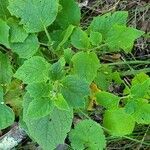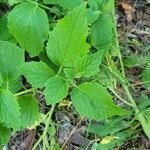Erect or spreading, rhizomatous perennial 2–9 dm; pubescence of the upper parts, pedicels, and cal distinctly villous, of slender, spreading hairs; lvs chiefly ovate or rhombic, 3–8 cm, acute, shallowly and irregularly sinuate-dentate or sometimes entire, broadly rounded or subcordate at base, not decurrent, hairy on both sides; pedicels to 1 cm at anthesis, to 3 cm in fr; cal-lobes deltoid or ovate, the margins straight or slightly concave; cor 12–20 mm; filaments dilated at the summit, about as broad as the anthers, these 3–4.5 mm long; fruiting cal ovoid, 3–4 cm, retuse at base; fr green; 2n=24. Dry or sandy soil, upland woods, and prairies, probably our most abundant sp.; Que. and N.S. to Minn., Colo., and Utah, s. to Fla. and Tex. June–Sept. Typical P. heterophylla has the hairs of the stem and lower lf-surface very fine, viscid, and densely crowded, seldom over 0.5 mm, more copious on the lf-veins than across the surface. Plants with sparser, more uniformly distributed pubescence, of jointed hairs 1–2 mm, with a similar range but not extending quite so far n., have been called var. ambigua (A. Gray) Rydb. (P. ambigua; P. nyctaginea), but the difference is only doubtfully significant.
More
A small plant that keeps growing from year to year. It grows 50 cm tall. It has a stout rhizome or underground stem. The stems are erect and hairy. The leaves have glandular hairs. The leaves are 6 cm long by 5 cm wide. They are almost heart shaped with a few irregular coarse teeth along the edge. The flowers occur singly. They are yellow and funnel shaped. They are purple at their base. The fruit are yellow when ripe and contain many seeds. The fruit are 3 cm long by 2.5 cm across. They are enclosed in a papery husk.
The ripe fruit are eaten raw. They can be made into pies, jams, sauces, syrup, preserves or soup. (Pectin must be added when making jam.) Dried fruit can be ground into meal and used in bread. The dried fruit are stored for later use.


